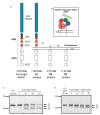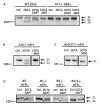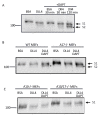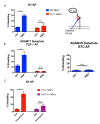Analysis of the Conditions That Affect the Selective Processing of Endogenous Notch1 by ADAM10 and ADAM17
- PMID: 33673337
- PMCID: PMC7918056
- DOI: 10.3390/ijms22041846
Analysis of the Conditions That Affect the Selective Processing of Endogenous Notch1 by ADAM10 and ADAM17
Abstract
Notch signaling is critical for controlling a variety of cell fate decisions during metazoan development and homeostasis. This unique, highly conserved signaling pathway relies on cell-to-cell contact, which triggers the proteolytic release of the cytoplasmic domain of the membrane-anchored transcription factor Notch from the membrane. A disintegrin and metalloproteinase (ADAM) proteins are crucial for Notch activation by processing its S2 site. While ADAM10 cleaves Notch1 under physiological, ligand-dependent conditions, ADAM17 mainly cleaves Notch1 under ligand-independent conditions. However, the mechanism(s) that regulate the distinct contributions of these ADAMs in Notch processing remain unclear. Using cell-based assays in mouse embryonic fibroblasts (mEFs) lacking ADAM10 and/or ADAM17, we aimed to clarify what determines the relative contributions of ADAM10 and ADAM17 to ligand-dependent or ligand-independent Notch processing. We found that EDTA-stimulated ADAM17-dependent Notch1 processing is rapid and requires the ADAM17-regulators iRhom1 and iRhom2, whereas the Delta-like 4-induced ligand-dependent Notch1 processing is slower and requires ADAM10. The selectivity of ADAM17 for EDTA-induced Notch1 processing can most likely be explained by a preference for ADAM17 over ADAM10 for the Notch1 cleavage site and by the stronger inhibition of ADAM10 by EDTA. The physiological ADAM10-dependent processing of Notch1 cannot be compensated for by ADAM17 in Adam10-/- mEFs, or by other ADAMs shown here to be able to cleave the Notch1 cleavage site, such as ADAMs9, 12, and 19. Collectively, these results provide new insights into the mechanisms underlying the substrate selectivity of ADAM10 and ADAM17 towards Notch1.
Keywords: ADAM10; ADAM17; Notch pathway; Notch receptor; Notch1; cell signaling; intercellular signaling; juxtacrine signaling; proteolysis; regulation.
Conflict of interest statement
Carl Blobel holds a patent on a method of identifying agents for combination with inhibitors of iRhoms. Carl Blobel and the Hospital for Special Surgery have identified iRhom2 inhibitors and have co-founded the start-up company SciRhom in Munich to commercialize these inhibitors.
Figures







Similar articles
-
The xenoestrogens biphenol-A and nonylphenol differentially regulate metalloprotease-mediated shedding of EGFR ligands.J Cell Physiol. 2018 Mar;233(3):2247-2256. doi: 10.1002/jcp.26097. Epub 2017 Aug 25. J Cell Physiol. 2018. PMID: 28703301 Free PMC article.
-
A Disintegrin and Metalloproteinase10 (ADAM10) Regulates NOTCH Signaling during Early Retinal Development.PLoS One. 2016 May 25;11(5):e0156184. doi: 10.1371/journal.pone.0156184. eCollection 2016. PLoS One. 2016. PMID: 27224017 Free PMC article.
-
Selective use of ADAM10 and ADAM17 in activation of Notch1 signaling.Mol Cell Biol. 2009 Nov;29(21):5679-95. doi: 10.1128/MCB.00406-09. Epub 2009 Aug 24. Mol Cell Biol. 2009. PMID: 19704010 Free PMC article.
-
Regulation of A disintegrin and metalloproteinase (ADAM) family sheddases ADAM10 and ADAM17: The emerging role of tetraspanins and rhomboids.Platelets. 2017 Jun;28(4):333-341. doi: 10.1080/09537104.2016.1184751. Epub 2016 Jun 2. Platelets. 2017. PMID: 27256961 Free PMC article. Review.
-
Role of ADAM10 in intestinal crypt homeostasis and tumorigenesis.Biochim Biophys Acta Mol Cell Res. 2017 Nov;1864(11 Pt B):2228-2239. doi: 10.1016/j.bbamcr.2017.07.011. Epub 2017 Jul 22. Biochim Biophys Acta Mol Cell Res. 2017. PMID: 28739265 Free PMC article. Review.
Cited by
-
ADAM17 variant causes hair loss via ubiquitin ligase TRIM47-mediated degradation.JCI Insight. 2024 May 21;9(13):e177588. doi: 10.1172/jci.insight.177588. JCI Insight. 2024. PMID: 38771644 Free PMC article.
-
Extracellular vesicles in triple-negative breast cancer: current updates, challenges and future prospects.Front Mol Biosci. 2025 Apr 14;12:1561464. doi: 10.3389/fmolb.2025.1561464. eCollection 2025. Front Mol Biosci. 2025. PMID: 40297849 Free PMC article. Review.
-
Consequences of Amyloid-β Deficiency for the Liver.Adv Sci (Weinh). 2024 May;11(18):e2307734. doi: 10.1002/advs.202307734. Epub 2024 Mar 2. Adv Sci (Weinh). 2024. PMID: 38430535 Free PMC article.
-
NOTCH localizes to mitochondria through the TBC1D15-FIS1 interaction and is stabilized via blockade of E3 ligase and CDK8 recruitment to reprogram tumor-initiating cells.Exp Mol Med. 2024 Feb;56(2):461-477. doi: 10.1038/s12276-024-01174-6. Epub 2024 Feb 27. Exp Mol Med. 2024. PMID: 38409448 Free PMC article.
-
Pleiotropic Roles of NOTCH1 Signaling in the Loss of Maturational Arrest of Human Osteoarthritic Chondrocytes.Int J Mol Sci. 2021 Nov 5;22(21):12012. doi: 10.3390/ijms222112012. Int J Mol Sci. 2021. PMID: 34769441 Free PMC article.
References
MeSH terms
Substances
Grants and funding
LinkOut - more resources
Full Text Sources
Other Literature Sources
Miscellaneous

